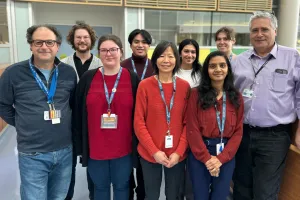Discovery points to innovative new way to treat Duchenne muscular dystrophy
 Researchers at The Ottawa Hospital and the University of Ottawa have discovered a new way to treat the loss of muscle function caused by Duchenne muscular dystrophy in animal models of the disease. As reported in Cell Stem Cell, the team restored muscle stem cell function that is impaired in Duchenne muscular dystophy, resulting in efficient regeneration of the muscle and preventing the progressive loss of muscle strength characteristic of the disease.
Researchers at The Ottawa Hospital and the University of Ottawa have discovered a new way to treat the loss of muscle function caused by Duchenne muscular dystrophy in animal models of the disease. As reported in Cell Stem Cell, the team restored muscle stem cell function that is impaired in Duchenne muscular dystophy, resulting in efficient regeneration of the muscle and preventing the progressive loss of muscle strength characteristic of the disease.
"This is a huge step forward in developing a new approach for treating Duchenne muscular dystrophy," said Dr. Michael Rudnicki, senior scientist and Director of the Regenerative Medicine Program at The Ottawa Hospital and a professor at the University of Ottawa. "We were able to preserve the muscle strength and function that are usually lost over time in this disease."
Duchenne muscular dystrophy is an inherited disease that weakens the muscles and causes death by the second or third decade of life. About one in 3,600 boys live with this condition, and there is no cure.
Dr. Rudnicki's team previously made the landmark discovery that Duchenne muscular dystrophy affects muscle stem cells, not just the muscle fibers. Muscle stem cells are responsible for repairing muscle fibers after injury and exercise. In people with Duchenne muscular dystrophy, their stem cells do not produce enough of the cells that will become muscle cells. This is because they are missing a protein called dystrophin, which properly orients the cell division needed to form new muscle cells.
The team found that activating a protein called epidermal growth factor receptor (EGFR) could restore this pathway and create new muscle cells, without the need for dystrophin.
The researchers inserted a gene that produced a steady supply of EGF into the muscle of a mouse model of Duchenne muscular dystrophy before symptoms of the disease began. After one month, the treated mice had 18 percent more muscle mass and less muscle scarring than untreated controls. The treated mice also had 30 percent more muscle fibers, and the muscles generated 32 percent more force compared to untreated mice. Muscle function was restored to almost normal levels.
This proof-of-concept study shows that the muscle repair pathway in Duchenne muscular dystrophy is correctable. However, EGF would not be a practical treatment because the protein cannot travel from the bloodstream into the muscles. The researchers' next step is to find a small-molecule drug that triggers this same pathway and can be easily delivered through the bloodstream. They will also look at the long-term effects of triggering this pathway, as the therapy would likely be taken throughout life.
"Duchenne muscular dystrophy is complex, and we will probably need a combination of treatments to address all aspects of the disease," said Dr. Rudnicki. EGF treatment enhances muscle repair after injury in a mouse model of Duchenne muscular dystrophy. Colour represents individual muscle fibers in muscle cross sections. Image courtesy of Cell Stem Cell.
EGF treatment enhances muscle repair after injury in a mouse model of Duchenne muscular dystrophy. Colour represents individual muscle fibers in muscle cross sections. Image courtesy of Cell Stem Cell.
Acknowledgements: This research was possible because of generous donations to The Ottawa Hospital for regenerative medicine research. This research was also funded by the US National Institutes for Health, the Canadian Institutes for Health Research, Muscular Dystrophy Canada, the Muscular Dystrophy Association, the Ontario Institute for Regenerative Medicine, and the Stem Cell Network. It was also supported by StemCore Laboratories. Dr. Rudnicki is a founder of Satellos Bioscience Inc., a company that is advancing this research.
Full Reference: EGFR-Aurka Signaling Rescues Polarity and Regeneration Defects in Dystrophin-Deficient Muscle Stem Cells by Increasing Asymmetric Divisions. Yu Xin Wang, Peter Feige, Caroline E. Brun, Bahareh Hekmatnejad, Nicolas A.Dumont, Jean-Marc Renaud, Sharlene Faulkes, Dan Guindon, and Michael A. Rudnicki. Cell Stem Cell. January 31, 2019.
About The Ottawa Hospital: Inspired by research. Driven by compassion. The Ottawa Hospital is one of Canada's largest learning and research hospitals with over 1,100 beds, approximately 12,000 staff and an annual budget of over $1.2 billion. Our focus on research and learning helps us develop new and innovative ways to treat patients and improve care. As a multi-campus hospital, affiliated with the University of Ottawa, we deliver specialized care to the Eastern Ontario region, but our techniques and research discoveries are adopted around the world. We engage the community at all levels to support our vision for better patient care. See www.ohri.ca for more information about research at The Ottawa Hospital.
About the University of Ottawa --A crossroads of cultures and ideas: The University of Ottawa is home to over 50,000 students, faculty and staff, who live, work and study in both French and English. Our campus is a crossroads of cultures and ideas, where bold minds come together to inspire game-changing ideas. We are one of Canada's top 10 research universities--our professors and researchers explore new approaches to today's challenges. One of a handful of Canadian universities ranked among the top 200 in the world, we attract exceptional thinkers and welcome diverse perspectives from across the globe. www.uottawa.ca
Media Contact: Amelia Buchanan, Senior Communication Specialist, Ottawa Hospital Research Institute; ambuchanan@ohri.ca; Office: 613-798-5555 x 73687; Cell: 613-297-8315
Learn more about:
The Ottawa Hospital is a leading academic health, research and learning hospital proudly affiliated with the University of Ottawa and supported by The Ottawa Hospital Foundation.


